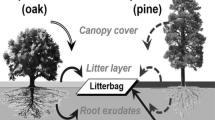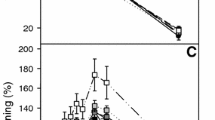Abstract
We investigated the influence of the exotic nitrogen-fixing black locust (Robinia pseudoacacia) on nitrogen cycling in a pitch pine (Pinus rigida) −scrub oak (Quercus ilicifolia, Q. prinoides) ecosystem. Within paired pine-oak and adjacent black locust stands that were the result of a 20-35 year-old invasion, we evaluated soil nutrient contents, soil nitrogen transformation rates, and annual litterfall biomass and nitrogen concentrations. In the A horizon, black locust soils had 1.3-3.2 times greater nitrogen concentration relative to soils within pine-oak stands. Black locust soils also had elevated levels of P and Ca, net nitrification rates and total net N-mineralization rates. Net nitrification rates were 25-120 times greater in black locust than in pine-oak stands. Elevated net N-mineralization rates in black locust stands were associated with an abundance of high nitrogen, low lignin leaf litter, with 86 kg N ha–1 yr–1 in leaf litter returned compared with 19 kg N ha–1 yr–1 in pine-oak stands. This difference resulted from a two-fold greater litterfall mass combined with increased litter nitrogen concentration in black locust stands (1.1% and 2.6% N for scrub oak and black locust litter, respectively). Thus, black locust supplements soil nitrogen pools, increases nitrogen return in litterfall, and enhances soil nitrogen mineralization rates when it invades nutrient poor, pine-oak ecosystems.
Similar content being viewed by others
References
Anderson R.C., Fralish J.S. and Baskin J.M. (eds), 1999. Savannas, barrens, and rock outcrop plant communities of North America. Cambridge University Press, Cambridge, UK.
Berendse F., Oomes M.J.M., Altena H.J. and Elberse W.Th. 1992. Experiments on the restoration of species-rich meadows in The Netherlands. Biological Conservation 62: 59–65.
Binkley D., Sollins P., Bell R., Sachs D. and Myrold D. 1992. Bio-geochemistry of adjacent conifer and alder-conifer stands. Ecology 73:2022–2033.
Boring L.R. and Swank W.T. 1984. The role of black locust (Robinia pseudoacacia)in forest succession. Journal of Ecology 72: 749–766.
Copenheaver C.A., White A.S. and Patterson III W.A. 2000. Vegetation development in a southern Maine pitch pine-scrub oak barren. Journal of the Torrey Botanical Society 127: 19–32.
D'Antonio C.M. and Corbin J.D. 2003. Effects of plant invaders on nutrient cycling-exploring the link between invasion and development of species effects. In: Canham C., Cole J.J. and Lauenroth W.K. (eds.), Models in ecosystem science. Princeton University Press, Princeton, New Jersey, USA.
D'Antonio C.M. and Vitousek P.M. 1992. Biological invasions by exotic grasses, the grass/fire cycle, and global changes. Annual Review of Ecology and Systematics 23: 63–87.
Ehrenfeld J.G., Kourtev P. and Huang W. 2001. Changes in soil functions following invasions of exotic understory plants in deciduous forests. Ecological Applications 11: 1287–1300.
Evans R.D., Rimer R., Sperry L. and Belnap J. 2001. Exotic plant invasion alters nitrogen dynamics in an arid grassland. Ecological Applications 11: 1301–1310.
Finton A.D. 1998. Succession and plant community development in pitch pine-scrub oak barrens of the glaciated northeastern United States. Master's Thesis, University of Massachusetts, Amherst, Massachusetts, USA.
Foster B.L. and Gross K.L. 1998. Species richness in a successional grassland: effects of nitrogen enrichment and plant litter. Ecology 79: 2593–2602.
Gough M.W. and Marrs R.H. 1990. A comparison of soil fertility between semi-natural and agricultural plant communities: impli-cations for the creation of floristically rich grassland on aban-doned agricultural land. Biological Conservation 51: 83–96.
Johnson D.W. and Reuss J.O. 1984. Soil-mediated effects of atmo-spherically deposited sulphur and nitrogen. Philosophical Trans-actions of the Royal Society of London series B 305: 383–392.
Mack M.C. and D'Antonio C.M. 1998. Impacts of biological in-vasions on disturbance regimes. Trends in Ecology and Evolution 13: 195–198.
Mack R.N., Simberloff D., Lonsdale W.M., Evans H., Clout M. and Bazzaz F. 2000. Biotic invasions: causes, epidemiology, global consequences and control. Issues in Ecology, No. 5, Spring. Ecological Society of America, Washington, DC, USA.
Maron J.L. and Connors P.G. 1996. A native nitrogen-fixing shrub facilitates weed invasion. Oecologia 105: 302–312.
Maron J.L. and Jefferies R.L. 1999. Bush lupine mortality, altered resource availability, and alternative vegetation states. Ecology 80: 443–454.
Maron J.L. and Jefferies R.L. 2001. Restoring enriched grasslands: effects of mowing on species richness, productivity, and nitro-gen retention. Ecological Applications 11: 1088–1100.
Marrs R.H. 1985. Techniques for reducing soil fertility for nature conservation purposes: a review in relation to research at Rop-er's Heath, Suffolk, England. Biological Conservation 34: 307–332.
Marrs R.H. 1993. Soil fertility and nature conservation in Europe: theoretical considerations and practical management solutions. Advances in Ecological Research 24: 241–300.
Marrs R.H, Snow C.S.R., Owen K.M. and Evans C.E. 1998. Heathland and acid grassland creation on arable soils at Minsmere: identification of potential problems and a test of cropping to impoverish soils. Biological Conservation 85: 69–82.
Marrs R.H., Gough M.W. and Griffiths M. 1991. Soil chemistry and leaching losses of nutrients from semi-natural grassland and ar-able soils on three contrasting parent materials. Biological Con-servation 57: 257–271.
McCormick J. 1979. The vegetation of the New Jersey Pine Barrens. pp. 229–242. In: Forman R.T.T. (ed.), Pine barrens: ecosystem and landscape. Academic Press, New York, New York, USA.
Milne B.T. 1985. Upland vegetational gradients and post-fire succession in the Albany Pine Bush, New York. Bulletin of the Torrey Botanical Club 112: 21–34.
Mitchell R.J., Auld M.H.D., Hughes J.M. and Marrs R.H. 2000. Estimates of nutrient removal during heathland restoration on successional sites in Dorset, southern England. Biological Con-servation 95: 233–246.
Mitchell R.S. and Tucker G.C. 1997. Revised checklist of New York State plants. Bulletin No. 490, New York State Museum, Albany, New York, USA.
Montagnini F., Haines B. and Swank W. 1989. Factors controlling nitrification in soils of early successional oak/hickory forests in the Southern Appalachians. Forest Ecology and Management 26: 77–94.
Montagnini F., Haines B. and Swank W. 1991. Soil-solution chem-istry in black locust, pine/mixed-hardwoods and oak/hickory forest stands in the southern Appalachians, U.S.A. Forest Ecol-ogy and Management 40: 199–208.
Olsvig L.S., Cryan J.F. and Whitaker R.H. 1979. Vegetation gradi-ents of the pine plains and barrens of Long Island, New York. pp. 283–293. In: Forman R.T.T. (ed.), Pine barrens: ecosystem and landscape. Academic Press, New York, New York, USA.
Peloquin R.L. and Heibert R.D. 1999. The effects of black locust (Robinia pseudoacacia L.)on species diversity and composition of black oak savanna/woodland communities. Natural Areas Journal 19: 121–131.
Pywell R.F., Webb N.R. and Putwain P.D. 1994. Soil fertility and its implications for the restoration of heathland on farmland in southern Britton. Biological Conservation 70: 169–181.
Reich P.B., Grigal D.F., Aber J.D. and Gower S.T. 1997. Nitrogen mineralization and productivity in 50 hardwood and conifer stands on diverse soils. Ecology 78: 335–47.
Reschke C. 1990. Ecological communities of New York State. New York Natural Heritage Program, New York State Department of Environmental Conservation, Latham, New York, USA.
Rittner D. (ed.), 1976a. Pine bush, Albany's last frontier. Pine Bush Historic Preservation Project, Albany, New York, USA.
Rittner D. 1976b. Flora of the pine bush. pp. 103–166. In: Rittner D. (ed.), Pine bush, Albany's last frontier. Pine Bush Historic Preservation Project, Albany, New York, USA.
Rizand A., Marrs R.H., Gough M.W. and Wells T.C.E. 1989. Long-term effects of various conservation management treat-ments on selected soil properties of chalk grassland. Biological Conservation 49: 105–112.
Schlesinger W.H. 1997. Biogeochemistry: an analysis of global change, 2nd edition. Academic Press, New York, New York, USA.
Seischab F.K. and Bernard J.M. 1996. Pitch pine (Pinus rigida Mill.)communities in the Hudson Valley Region of New York. American Midland Naturalist 136: 42–56.
Stock W.D., Wienand K.T. and Baker A.C. 1995. Impacts of in-vading N2 fixing Acacia species on patterns of nutrient cycling in two Cape ecosystems: evidence from soil incubation studies and 15N natural abundance values. Oecologia 101: 375–382.
Storer D.A. 1984. A simple high sample volume ashing procedure for determination of soil organic matter. Communications in Soil Science and Plant Analysis 15: 759–772.
Tallowin J.R.B. and Smith R.E.N. 2001. Restoration of a Cirsio-Molinietum fen on an agriculturally improved pasture. Restoration Ecology 9: 167–78.
Tilman D. 1986. Nitrogen-limited growth in plants from different successional stages. Ecology 67: 555–563.
Tilman D. and Wedin D. 1991. Dynamics of nitrogen competition between successional grasses. Ecology 72: 1038–1049.
Vitousek P.M. and Walker L.R. 1989. Biological invasion by Myrica faya in Hawai'i: plant demography, nitrogen fixation and ecosystem effects. Ecological Monographs 59: 247–265.
Walker L.R. and Vitousek P.M. 1991. An invader alters germina-tion and growth of a native dominant tree in Hawaii. Ecology 72: 1449–1455.
Wedin D.A. and Tilman D. 1996. Influence of nitrogen loading and species composition on the carbon balance of grasslands. Science 274: 1720–1723.
Witkowski E.T.F. 1991. Effects of alien Acacias on nutrient cycling in coastal lowlands of the Cape Fynbos. Journal of Applied Ecology 28: 1–15.
Zak D.R. and Pregitzer K.S. 1990. Spatial and temporal variability of nitrogen cycling in northern lower Michigan. Forest Science 36: 367–380.
Zak D.R., Hairston A. and Grigal D.F. 1991. Topographic influences on nitrogen cycling within an upland pin oak ecosystem. Forest Science 37: 45–53.
Author information
Authors and Affiliations
Corresponding author
Rights and permissions
About this article
Cite this article
Rice, S.K., Westerman, B. & Federici, R. Impacts of the exotic, nitrogen-fixing black locust (Robinia pseudoacacia) on nitrogen-cycling in a pine–oak ecosystem. Plant Ecology 174, 97–107 (2004). https://doi.org/10.1023/B:VEGE.0000046049.21900.5a
Issue Date:
DOI: https://doi.org/10.1023/B:VEGE.0000046049.21900.5a




